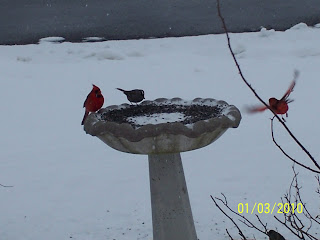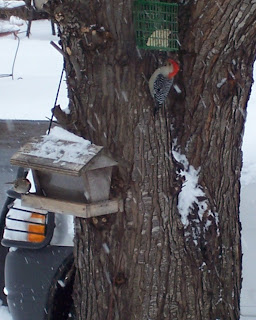 |
| Cardinals on the fence wait their turn for the feeder. |
 |
| A group of goldfinches visit the nyjer feeder. |
There is a wide variety of beautiful songbirds that can be found in the Ozark Mountains of North Central Arkansas. Many of these are year round residents, but some are migratory and only visit us during certain times of the year. Offering a variety of foods in your front and/or back yard can help attract many of these lovely creatures to your neighborhood. You will be rewarded with beautiful colors, sights, sounds, and playful antics to keep you and your neighbors amused.
I regularly see cardinals, bluebirds, doves, house finches, goldfinches, wrens, chickadees, nuthatches, woodpeckers, titmice, hummingbirds, bluejays, mockingbirds, and several other birds. Unfortunately, the blackbirds, grackles, starlings, and sparrows also make frequent appearances at and around my feeders.
Neither squirrel or blue jay seem to be bothered by the other.
Large gatherings of blackbird, grackles, and starlings
appear in the Spring. They gobble up food meant for the
songbirds. There is little you can do to deter them from
coming to your feeders.
Almost every bird that visits my feeders loves black oil sunflower seeds. That's usually what I buy most often. I've tried mixed seed several times, but it's mostly filler. Most birds will not eat milo seed or red millet seed, while only a few will eat the white proso millet seeds. If these seeds are in a feeder, you will soon find a pile of them underneath the feeder as the birds toss them aside in search of the sunflower seeds.
Black oil sunflower seeds, by far the
favorite food at the home feeders.
Milo seeds - Most birds will not eat this.
Red millet seed. Again, most birds do not like these.
Safflower seeds. Cardinals like them, but squirrels
supposedly do not. If you have a problem with squirrels
getting into the sunflower seeds, you might try these, but they
cost about $20 for only a 20 pound bag.
 |
| White millet seeds. Doves will eat these if you sprinkle them on ground. Sparrows will sometimes eat these out of the feeders. Cardinals and other songbirds will not eat them. |
 |
| Doves love to perch on overhead power lines. They only feed on the ground. They will not eat from a hanging feeder. Doves will eat sunflower seeds and sometimes white millett. |
Two American Goldfinches at a tube feeder with nyjer seed.
The American Goldfinch will visit your feeder for sunflower seeds during the winter and early spring, but if you hope to keep them around all season you must put up a tube feeder containing the rather expensive tiny nyjer seeds, which they love. Nyjer seeds are very similiar to the native thistle seed, which you will see flocks of goldfinches devouring in the open fields in the early autumn when the thistle plants go to seed.
A blue jay selects a morsel of bread from the ground.
Many folks consider bluejays to be little more than nuisances and don't want them around. While bluejays can be aggressive toward the other birds, I love it when they stop by. Their antics and pickiness can be very amusing. Bluejays love nuts, such as unsalted peanuts in the shell. You can put some on the ground and wait for the bluejays to appear. They are picky, and will sometimes pick up several peanuts, then drop them until they find just the right one and then fly off with it. Bluejays will also eat sunflower seeds from the feeder. Apparently they cannot crack the seeds with the beaks, so the ones who visit my feeders select a seed, fly up to my wooden fence, then continuously smash the seed against the fence until the shell breaks. They sound almost like a woodpecker !
Mockingbirds are inquisitive backyard residents. They perch on the powerlines and watch everything going on below. Mockingbirds do not eat seed from the feeder. They eat mostly insects. However, I found one treat they cannot seem to resist. One day this summer I opened a small can of mandarin oranges and placed them on the ground. Within just a few minutes, the mockingbird flew down and started gobbling them up, big chunks at a time. He ate the entire can of oranges in just a few minutes. What a surprise that was !
The Eastern Bluebird will take up residence in your back yard if you put up a bluebird box about 6 feet off the ground. They do not eat seed either, but search for bugs, worms, and insects. Do not place the birdhouse too close to a feeder, as the bluebird may become anxious or nervous of other birds and abandon its nest, even after it has built up a full nest inside.
A red headed woodpecker enjoys
a suet cake treat.
For attracting woodpeckers, a mesh container for holding inexpensive suet cakes is essential. Woodpeckers love suet and will visit often each day. They will also occasionally eat sunflower seeds. Unfortunately, blackbirds also love suet and will take over unless you find a way to turn them away. I discovered that if you leave the suet cake inside the plastic container, with only the top open, then place it and hang it upside down in the mesh container, the blackbirds can't get to it. Blackbirds cannot hang upside down and eat the suet, but it's no problem at all for the woodpeckers. Problem solved :-)
Hummingbirds will come to your yard during the summer if you offer sugarwater in a feeder. These little creatures will buzz and chatter around the yard all day long if you have a feeder. They are remarkably loud and noisy for such small birds. Rather than buy the solution or mix in the store, I simply make a syrup of about 1 cup sugar to 2 1/2 cups of water. Bring to a boil on the stove, let it cool, then pour into the feeder. You can add red food coloring if you want, but it's not necessary. Make sure you wash the feeder out between fillings to get rid of harmful bacteria. Not only will the sugarwater feeder attract hummingbirds, it will also attract armies of small ants and honeybees too.
I've offered several other foods to see if the birds like them, such as blueberries, halved grapes, pieces of strawberry and etc., but without much success. Most birds ignored them and continued going after the sunflower seeds. Some of them will eat pieces of bread or toast.
Goldfinches at the sunflower seed feeders on
a snowy winter day. Goldfinches lose their
distinctive sunny yellow coloring during the winter.
Cardinals and others appreciate a feeder with
sunflower seeds during the winter and also year round.
The placement of the feeders is important. Most of the songbirds appreciate a shrub or small tree nearby the feeder that will offer some cover and concealment from predators. A stand alone feeder in the middle of the yard, with no cover around, will be little used. Also, offering water for the birds is just as essential as the feeder. I keep two birdbaths filled with clean water.
A bird bath is essential to keep the birds coming back.
Many people only feed the songbirds during the winter when natural food sources are scarce. However, I have found that even though visits to the feeder will drop off somewhat during the summer, most birds continue visiting my feeders all year long. I think my very favorite time to watch birds at the feeder is during a snowstorm. The cardinals will show up in such large groups that the feeders and trees will be covered in a sea of red. I've counted as many as 35 or 40 red cardinals waiting for their turn at the feeder during a snowstorm, in addition to the other birds.
Many cardinals await their turn for the feeder
on a snowy February morning.













